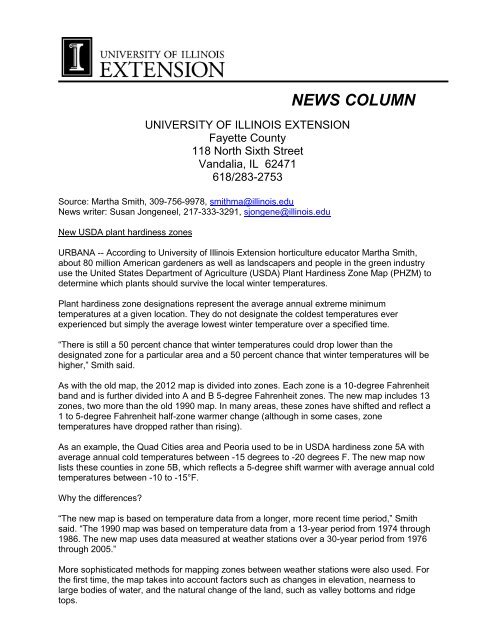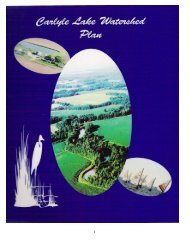New USDA Plant Hardiness Zone - Fayette County SWCD
New USDA Plant Hardiness Zone - Fayette County SWCD
New USDA Plant Hardiness Zone - Fayette County SWCD
You also want an ePaper? Increase the reach of your titles
YUMPU automatically turns print PDFs into web optimized ePapers that Google loves.
UNIVERSITY OF ILLINOIS EXTENSION<br />
<strong>Fayette</strong> <strong>County</strong><br />
118 North Sixth Street<br />
Vandalia, IL 62471<br />
618/283-2753<br />
Source: Martha Smith, 309-756-9978, smithma@illinois.edu<br />
<strong>New</strong>s writer: Susan Jongeneel, 217-333-3291, sjongene@illinois.edu<br />
<strong>New</strong> <strong>USDA</strong> plant hardiness zones<br />
NEWS COLUMN<br />
URBANA -- According to University of Illinois Extension horticulture educator Martha Smith,<br />
about 80 million American gardeners as well as landscapers and people in the green industry<br />
use the United States Department of Agriculture (<strong>USDA</strong>) <strong>Plant</strong> <strong>Hardiness</strong> <strong>Zone</strong> Map (PHZM) to<br />
determine which plants should survive the local winter temperatures.<br />
<strong>Plant</strong> hardiness zone designations represent the average annual extreme minimum<br />
temperatures at a given location. They do not designate the coldest temperatures ever<br />
experienced but simply the average lowest winter temperature over a specified time.<br />
“There is still a 50 percent chance that winter temperatures could drop lower than the<br />
designated zone for a particular area and a 50 percent chance that winter temperatures will be<br />
higher,” Smith said.<br />
As with the old map, the 2012 map is divided into zones. Each zone is a 10-degree Fahrenheit<br />
band and is further divided into A and B 5-degree Fahrenheit zones. The new map includes 13<br />
zones, two more than the old 1990 map. In many areas, these zones have shifted and reflect a<br />
1 to 5-degree Fahrenheit half-zone warmer change (although in some cases, zone<br />
temperatures have dropped rather than rising).<br />
As an example, the Quad Cities area and Peoria used to be in <strong>USDA</strong> hardiness zone 5A with<br />
average annual cold temperatures between -15 degrees to -20 degrees F. The new map now<br />
lists these counties in zone 5B, which reflects a 5-degree shift warmer with average annual cold<br />
temperatures between -10 to -15°F.<br />
Why the differences?<br />
“The new map is based on temperature data from a longer, more recent time period,” Smith<br />
said. “The 1990 map was based on temperature data from a 13-year period from 1974 through<br />
1986. The new map uses data measured at weather stations over a 30-year period from 1976<br />
through 2005.”<br />
More sophisticated methods for mapping zones between weather stations were also used. For<br />
the first time, the map takes into account factors such as changes in elevation, nearness to<br />
large bodies of water, and the natural change of the land, such as valley bottoms and ridge<br />
tops.
Another difference is that the 2012 map does not include Canada or Mexico. The creators<br />
focused on providing the best possible information for the United States and Puerto Rico.<br />
What do the changes in the new map mean as far as global warming is concerned?<br />
According to the <strong>USDA</strong> website, “Climate changes are usually based on trends in overall<br />
average temperatures recorded over 50 to100 years. Because the <strong>USDA</strong> PHZM represents 30-<br />
year averages of what are essentially extreme weather events (the coldest temperature of the<br />
year), changes in zones are not reliable evidence of whether there has been global warming.”<br />
The new map is available at http://planthardiness.ars.usda.gov/PHZMWeb/. For the first time, it<br />
is available both as an interactive GIS-based map, for which a broadband Internet connection is<br />
recommended, and as static images for users with slower Internet access. Zip codes can be<br />
used to find a plant hardiness zone.<br />
“As a 30-year-plus gardening veteran, I find change is good but not always easy to embrace,”<br />
said Smith. “It will take time not to immediately look for my old zone. I wonder when my<br />
flowering dogwood will realize it is 5 degrees warmer in my garden and bloom dependably every<br />
spring?“<br />
-30-<br />
Local Contact: University of Illinois Extension, Rachelle Hollinshead, <strong>County</strong> Extension Director,<br />
618/283-2753



